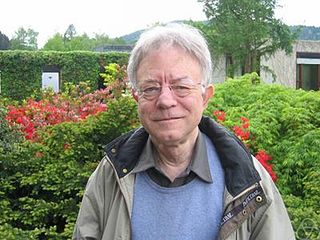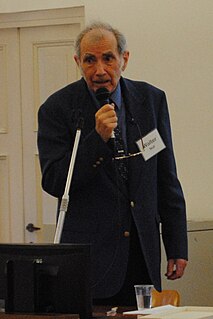
Mathematical physics refers to the development of mathematical methods for application to problems in physics. The Journal of Mathematical Physics defines the field as "the application of mathematics to problems in physics and the development of mathematical methods suitable for such applications and for the formulation of physical theories". It is a branch of applied mathematics, but deals with physical problems.
In fluid dynamics, within the framework of continuum mechanics, a fluid parcel is a very small amount of fluid, identifiable throughout its dynamic history while moving with the fluid flow. As it moves, the mass of a fluid parcel remains constant, while—in a compressible flow—its volume may change. And its shape changes due to the distortion by the flow. In an incompressible flow the volume of the fluid parcel is also a constant.

Francis William Lawvere is a mathematician known for his work in category theory, topos theory and the philosophy of mathematics.

Paul Felix Nemenyi was a Hungarian mathematician and physicist who specialized in continuum mechanics. He was known for using what he called the inverse or semi-inverse approach, which applied vector field analysis, to obtain numerous exact solutions of the nonlinear equations of gas dynamics, many of them representing rotational flows of nonuniform total energy. His work applied geometrical solutions to fluid dynamics. In continuum mechanics, "Nemenyi's theorem" proves that, given any net of isothermal curves, there exists a five parameter family of plane stress systems for which these curves are stress trajectories.

Clifford Ambrose Truesdell III was an American mathematician, natural philosopher, and historian of science.
The Indiana University Mathematics Journal is a journal of mathematics published by Indiana University. Its first volume was published in 1952, under the name Journal of Rational Mechanics and Analysis and edited by Václav Hlavatý and Clifford Truesdell. In 1957, Eberhard Hopf became editor, the journal name changed to the Journal of Mathematics and Mechanics, and Truesdell founded a separate successor journal, the Archive for Rational Mechanics and Analysis, now published by Springer-Verlag. The Journal of Mathematics and Mechanics later changed its name again to the present name. As of 2013, the managing editor is Chris Judge.

Giordano Riccati or Jordan Riccati was the first experimental mechanician to study material elastic moduli as we understand them today. His 1782 paper on determining the relative Young's moduli of steel and brass using flexural vibrations preceded Thomas Young's 1807 paper on the subject of moduli. The ratio that Riccati found was
The Clausius–Duhem inequality is a way of expressing the second law of thermodynamics that is used in continuum mechanics. This inequality is particularly useful in determining whether the constitutive relation of a material is thermodynamically allowable.

Antonio Signorini was an influential Italian mathematical physicist and civil engineer of the 20th century. He is known for his work in finite elasticity, thermoelasticity and for formulating the Signorini problem.
James Burton Serrin was an American mathematician, and a professor at University of Minnesota.
Jerald LaVerne Ericksen is an American mathematician specializing in continuum mechanics.
Morton E. Gurtin is a mechanical engineer who became a mathematician and de facto mathematical physicist. He is an emeritus professor of mathematical sciences at Carnegie-Mellon University, where for many years he held an endowed chair as the Alumni Professor of Mathematical Science. His main work is in materials science, in the form of the mathematical, rational mechanics of non-linear continuum mechanics and thermodynamics, in the style of Clifford Truesdell and Walter Noll, a field also known under the combined name of continuum thermomechanics. He has published over 250 papers, many among them in Archive for Rational Mechanics and Analysis, as well as a number of books.
Martin Feinberg is an American chemical engineer and mathematician known for his work in chemical reaction network theory.

Krzysztof Wilmanski was a Polish-German scientist working in the fields of continuum mechanics and thermodynamics.
Gérard A. Maugin was a French engineering scientist. Maugin acquired his engineering degree in mechanical engineering in 1966 at the Ecole Nationale Supérieure d'Arts et Métiers (Ensam) and he continued his studies at the school of aeronautics Sup Aéro in Paris until 1968. In 1966 he worked for the French Ministry of Defence on ballistic missiles. In 1968 he received his (DEA) degree in hydrodynamics in Paris. In 1969, he earned his master's degree from Princeton University, where he graduated in 1971 (Ph.D.). He was a NASA International Fellow between 1968 and 1970. In 1971/72 he was an officer in the French Air Force. In 1975 he received his doctorate in mathematics at the University of Paris VI, where he also taught and directed a team at the Laboratoire de Mécanique Théorique conducting research since 1985 on Continuum mechanics and Theoretical Mechanics. After its name change to the Laboratoire de Modélisation en Mécanique (LMM), he headed this from 1998. From 1979 he was Director of Research at CNRS.

David Samuel Kinderlehrer is an American mathematician, who works on partial differential equations and related mathematics applied to materials in biology and physics.
David Egorovich Dolidze was a Georgian and Soviet mathematician, known from his work in the mathematical theory of fluid motion. In particular he rediscovered an important uniqueness theorem for the classical solutions to the Navier–Stokes equations for an incompressible fluid, previously proved by Emanuele Foà.
In continuum physics, materials with memory, also referred as materials with hereditary effects are a class of materials whose constitutive equations contains a dependence upon the past history of thermodynamic, kinetic, electromagnetic or other kind of state variables.
Rational thermodynamics is a school of thought in statistical thermodynamics developed in the 1960s. Its introduction is attributed to Clifford Truesdell (1919–2000), Bernard Coleman and Walter Noll (1925–2017). The aim was to develop a mathematical model of thermodynamics that would go beyond the traditional "thermodynamics of irreversible processes" or TIP developed in the late 19th to early 20th centuries. Truesdell's "flamboyant style" and "satirical verve" caused controversy between "rational thermodynamics" and proponents of traditional thermodynamics.









